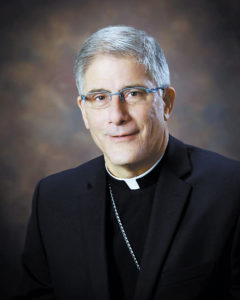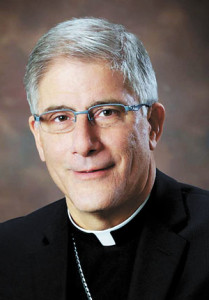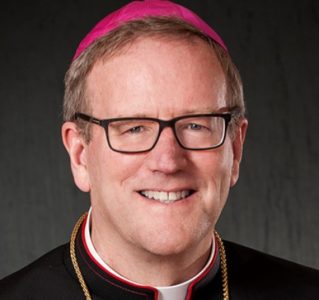
+ Obispo Joseph R. Kopacz
Por Obispo Joseph Kopacz
A lo largo de la Iglesia Católica en los Estados Unidos muchos están agonizando por las revelaciones de los crímenes, del Cardenal Theodore McCarrick contra menores, el flagrante abuso de poder y el comportamiento sexual desenfrenado con seminaristas y otros. Dolor, ira y vergüenza están ensombreciendo a los fieles y viejas heridas se reabren. Hay muchas preguntas sin respuesta, pero por más desagradable que sea la verdad, pues solo la verdad pondrá a las víctimas, sus familias y a la Iglesia en el camino hacia la sanación, la justicia y la nueva vida. La revelación del comportamiento pecaminoso de un prelado de alto rango en la Iglesia no resta valor a todo el buen trabajo que la Iglesia Católica ha hecho para proteger a los niños y jóvenes desde 2002, pero es un retroceso horrible en los esfuerzos para restaurar la confianza.
La vasta mayoría de las diócesis católicas en Estados Unidos han trabajado muy duro durante estos 16 años para ser fieles al documento conocido como La Carta de Dallas, titulada “ Promesa de Proteger y Compromiso de Sanar” (Promise to Protect and the Pledge to Heal; por su nombre en inglés). El fomento de entornos seguros en nuestros ministerios es ahora la norma, y el apoyo firme a las víctimas de abuso sexual que luchan por la sanación y la esperanza en sus vidas, ha sido un compromiso incansable.
Los resultados son dignos de elogio; los protocolos creados por los programas para una Iglesia de ambiente seguro han reducido significativamente los abusos a menores por miembros del personal de las iglesias. De igual manera sabemos que toma entre 20 y 30 años, como promedio, para que una víctima se decida a dar un paso adelante y cuente su trágica historia. Este fue el caso de las víctimas del Cardenal McCarrick. Muchos nunca revelan su herida porque es demasiado doloroso el hacerlo. Esta es la razón por la cual difundimos repetidamente la declaración que alienta, a todas las víctimas de abuso sexual por parte del personal de la Iglesia, a presentarse sin importar cuánto tiempo haya pasado desde ocurrido el abuso. El sufrimiento no tiene estatuto de limitaciones.
El abuso sexual es un mal y un crimen que causa estragos, destrucción y desesperación, por tanto el enemigo, el maligno se regocija en esto porque el abuso está envuelto en tinieblas, mentiras y vergüenza. El abuso desata el poder del infierno sobre las víctimas y sus familias y con frecuencia se propaga de una generación a otra, a menos que el ciclo se rompa a la luz de la verdad, la curación y la reconciliación.
Al principio de mi sacerdocio, durante un período de 15 años, tuve la oportunidad de enseñar Desarrollo Humano a adolescentes en tres de nuestras escuelas primarias en la Diócesis de Scranton. El don de la sexualidad está floreciendo a esta edad, y el saber que hay personas en la Iglesia que se aprovechan de estos jóvenes, adolescentes y de los menores en cada etapa de su desarrollo es un ataque desmedido contra la dignidad humana.
En la Diócesis de Jackson nos comprometemos a fomentar ambientes seguros en nuestras Escuelas Católicas, en nuestros Programas de Educación Religiosa y en nuestros Ministerios de la Juventud para que los niños y jóvenes que nos han sido confiados puedan alcanzar el potencial dado por Dios en cada aspecto de sus vidas.
Además, serví como Director de Formación durante 14 años en nuestro Seminario Universitario en Scranton, Pensilvania y escuchar de la explotación de jóvenes que están discerniendo una vocación por aquellos en autoridad y supuestos a nutrirlos, también clama al cielo por justicia. La transparencia y el cultivo de una cultura de confianza, respeto y responsabilidad son las normas de los seminarios donde nuestros seminaristas de Jackson están formándose: Saint Ben’s (Colegio Seminario St. Joseph) en Covington, Luisiana; Notre Dame en Nueva Orleans y el Sagrado Corazón en Hales Corner, Wisconsin.
Durante los dos últimos años, como miembro de la Conferencia de Obispos Católicos de los Estados Unidos (USCCB; por sus siglas en inglés), he estado sirviendo en el Comité para la Protección de Niños y Jóvenes. Esto me sitúa en el centro de la resolución permanente de la Iglesia de proteger y sanar, tal como se establece en La Carta de Dallas y de aplicar estos esfuerzos y mejores prácticas a nuestra propia red de Ambientes Seguros en nuestra Diócesis.
La Carta dirige la acción en los siguientes asuntos:
• Crear un ambiente seguro para niños y jóvenes;
• Sanación y reconciliación de víctimas y sobrevivientes;
• Hacer una respuesta pronta y efectiva a las acusaciones;
• Cooperar con las autoridades civiles;
• Disciplinar a los culpables;
• Proporcionar medios de rendición de cuentas para garantizar en el futuro que el problema continúe siendo tratado de manera efectiva a través de la Secretaría de Protección de Niños y Jóvenes y la Junta Nacional de Revisión.
Que el Señor Jesús, que dio la bienvenida a los niños y los abrazó en su amor, traiga la verdad que nos hará libres, la justicia que restablecerá las relaciones correctas con Dios y con los demás, la sanación y la reconciliación que son los estándares de todas las comunidades cristianas, su cuerpo, la Iglesia.




